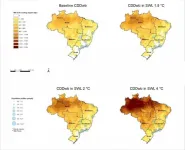Brazil: Air conditioning equipment days of use will double without climate action
2021-02-10
(Press-News.org) Space cooling already accounts for 14% of residential electricity demand in Brazil, and it is expected to increase further because of climate change.
Very few studies investigate the relationship between climate change, cooling needs, and electricity demand. In a new study in Energy and Buildings, a team of researchers from Universidade Federal do Rio de Janeiro and CMCC@Ca'Foscari - a joint program of Ca'Foscari University of Venice and CMCC Foundation - investigate how climate and income during the period 1970-2010 shaped cooling services in Brazil. This historical relationship allows projecting the resulting energy demand for cooling services across three warming scenarios: +1.5°C, +2°C, +4°C.
The study shows that the average air conditioning equipment days of use would increase by more than 100% in Brazil, in a 4°C warming scenario. This would substantially impact the need for space cooling and consequently, the associated energy consumption. But even in the case of more optimistic future warming scenarios, energy consumption - and consequent emissions - will increase. Because of cooling needs, average CO2 emissions, today of 0.62 Mt per year, are projected to increase in the three warming scenarios respectively by 70% (+1.5°C), 99% (+2°C) and 190% (+4°C).
"To define past and future ambient thermal comfort needs we use the wet-bulb Cooling Degree Days (CDDwb), a measure of temperature which accounts for air's humidity" explains Enrica De Cian from CMCC@Ca'Foscari, co-author of the study and principal investigator of the ERC Starting Grant project ENERGYA - Energy use for Adaptation. "Brazil is a very peculiar country as it varies widely in climatic conditions and population density. Our study shows that the highest temperature growth will happen in the northern region, characterised by low population density. Therefore, it will not translate into relevant energy consumption, excepting for the city of Manaus, the seventh largest city of Brazil, which is in the North region of the country, at the center of the Amazon rainforest".
The North is already saturated, with an average of 328 annual days of air conditioning use. On the opposite in the South region, a temperature increase of 4°C would inflate the energy consumption by almost 5 times.
Total energy demand for space cooling in the country may rise consistently because of the income effect alone, as it has been observed in the ?rst decade of this century. "In addition to temperature and population density, income of a region is crucial in shaping energy demand" explains Malcolm Mistry, a researcher at CMCC@Ca'Foscari. "Socio-economic drivers are also important to assess trends in ownership rates and types of air conditioning units in use, as typically there is a de?cit in achieving thermal comfort in many Brazilian households because of budget constraints."
Considering population and income increase alone, the ownership rate of space cooling appliances in Brazil can reach 96 air conditioning units per 100 households in 2035, compared to a current average of 40 units, boosting energy demand by 125%.
Energy ef?ciency can potentially reduce this growth in energy consumption observed for all warming scenarios. The potential carbon emissions avoided by energy savings from ef?ciency measures depends on the fuel mix of the power sector. In Brazil, the authors conclude, a 59% improvement of ef?ciency is feasible but it would require much more aggressive energy ef?ciency policies than those currently in place.
INFORMATION:
For more information:
Paula Bezerra, Fabioda Silva,Talita Cruza, Malcolm Mistry, Eveline Vasquez-Arroyo, Leticia Magalar, Enrica De Cian, André F. P. Lucena, Roberto Schaeffer, Impacts of a warmer world on space cooling demand in Brazilian households (2021), Energy and Buildings. https://doi.org/10.1016/j.enbuild.2020.110696
[Attachments] See images for this press release:

ELSE PRESS RELEASES FROM THIS DATE:
2021-02-10
WEST LAFAYETTE, Ind. - Emerging robotics technology may soon help construction companies and contractors create buildings in less time at higher quality and at lower costs.
Purdue University innovators developed and are testing a novel construction robotic system that uses an innovative mechanical design with advances in computer vision sensing technology to work in a construction setting.
The technology was developed with support from the National Science Foundation.
"Our work helps to address workforce shortages in the construction industry by automating key construction operations," said Jiansong Zhang, an assistant professor of construction ...
2021-02-10
The findings add to current knowledge of how insects fly and keep stable in the air. They could also help to inspire new designs in small aerial vehicles like drones, which can be useful for search-and-rescue attempts and building inspection.
Our colourful sunny-day companions can glide, fly backwards, and travel up to 54 km/h when hunting prey or escaping predators - but like any flying creature, they can be thrown off balance and even find themselves upside down.
Many land-based animals like cats, and aerial animals like hoverflies, rotate themselves around a head-to-tail ...
2021-02-10
During a study with captive vampire bats at the Smithsonian Tropical Research Institute (STRI) in Panama, a young vampire bat pup was adopted by an unrelated female after its mother died. Although this observation was not the first report of adoption in vampire bats, it is uniquely contextualized by more than 100 days of surveillance-camera footage. This footage captured by STRI research associate Gerry Carter's lab at Ohio State University reveals intimate details about the changing social relationships between the mother, the pup and the adoptive mother throughout their time in captivity.
"The adoption took place after a very sad but ultimately serendipitous occurrence," ...
2021-02-10
Adopting policies that are consistent with achieving the Paris Agreement and prioritise health, could save 6.4 million lives due to better diet, 1.6 million lives due to cleaner air, and 2.1 million lives due to increased exercise, per year, across nine countries.
New research from The Lancet Countdown on Health and Climate Change published in a special issue of The Lancet Planetary Health journal highlights the benefits to health if countries adopt climate plans - Nationally Determined Contributions (NDCs) - that are consistent with the Paris Agreement aim of limiting warming to "well below 2°C". [1,2]
The countries considered in the study represent ...
2021-02-10
The notion of social distancing rose to public prominence approximately a year ago, when health officials began recommending it as a way to slow the spread of the novel SARS-CoV-2 virus. Despite the novelty of the concept among many contemporary human audiences, social distancing has considerable precedent among animals.
Writing in BioScience, Mark Butler of Florida International University and Donald C. Behringer of the University of Florida outline the role of social distancing in nature and compare it with its human counterpart. They describe numerous animals in which distancing has evolved, including guppies, chimpanzees, birds, ants, and mice, among many others. ...
2021-02-09
The capture of the first living Coelacanth, a mighty ocean predator, off the coast of South Africa caused quite a stir in 1938, 65 million years after its supposed extinction. It became known as a "living fossil" owing to its anatomy looking almost identical to the fossil record. But while the Coelacanth's body may have changed little, its genome tells another story.
Toronto scientists have now revealed that the African Coelacanth, Latimeria chalumnae, gained 62 new genes through encounters with other species 10 million years ago. Their findings are reported in the journal Molecular Biology ...
2021-02-09
Headlines like "Black Friday Shoppers Trampled in New York" and popular television shows such as "Extreme Couponing" remind us how crazy consumers can get about retail sales promotions. This enthusiasm for getting bargains has been termed "deal proneness."
Past research has indicated that, to some degree, people become deal prone through being taught by their parents. But a new paper, "Born to Shop? A Genetic Component of Deal Proneness," published in the Journal of the Association for Consumer Research, provides evidence that our genes also play a role in causing bargain-hunting enthusiasm.
To demonstrate this genetic factor, authors Robert Schindler, Vishal Lala, and Jeanette Taylor ...
2021-02-09
Washington, DC-- New research led by Carnegie's Yingwei Fei provides a framework for understanding the interiors of super-Earths--rocky exoplanets between 1.5 and 2 times the size of our home planet--which is a prerequisite to assess their potential for habitability. Planets of this size are among the most abundant in exoplanetary systems. The paper is published in Nature Communications.
"Although observations of an exoplanet's atmospheric composition will be the first way to search for signatures of life beyond Earth, many aspects of a planet's surface habitability are influenced by what's happening beneath the planet's surface, and that's where ...
2021-02-09
Nutritionists have been touting the health benefits of seafood for years. Dietary guidelines recommend that the average adult get at least two servings of seafood per week. But the push to increase our consumption of seafood can put a strain on the seafood industry and create more waste.
"Many fisheries are fully or overexploited," said Lekelia "Kiki" Jenkins, an associate professor at Arizona State University's School for the Future of Innovation in Society in the College of Global Futures. "We are pushing our fisheries to the brink that they can sustain. Meanwhile, consumers are wasting nearly half of the fish they buy. We need to understand our waste behaviors and put a mechanism into place so that we use what we catch."
Jenkins is researching ways to improve sustainability in ...
2021-02-09
Announcing a new article publication for BIO Integration journal. In this review article the authors Yue Li, Zhiyi Chen and Shuping Ge from First Affiliated Hospital of University of South China, Hengyang, China and Tower Health and Drexel University, Philadelphia, PA, USA summarize current state of the art applications of microbubble-cell interactions and sonoporation effects to cellular functions.
Ultrasound combined with microbubble-mediated sonoporation has been applied to enhance drug or gene intracellular delivery. Sonoporation leads to the formation of openings in the cell membrane, triggered by ultrasound-mediated oscillations and destruction of microbubbles. Multiple mechanisms are involved in the occurrence ...
LAST 30 PRESS RELEASES:
[Press-News.org] Brazil: Air conditioning equipment days of use will double without climate action




